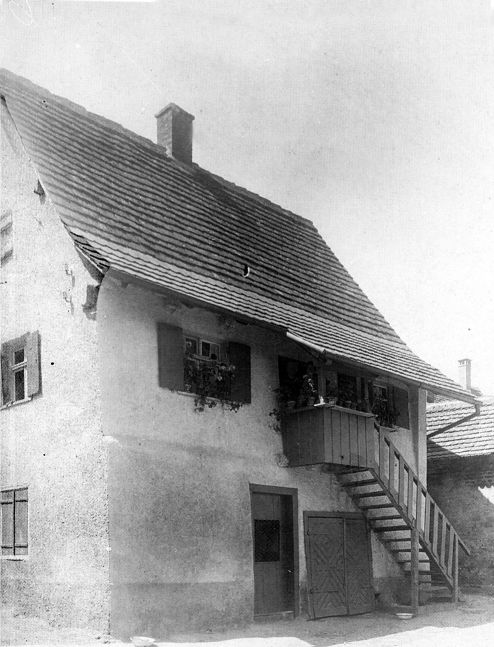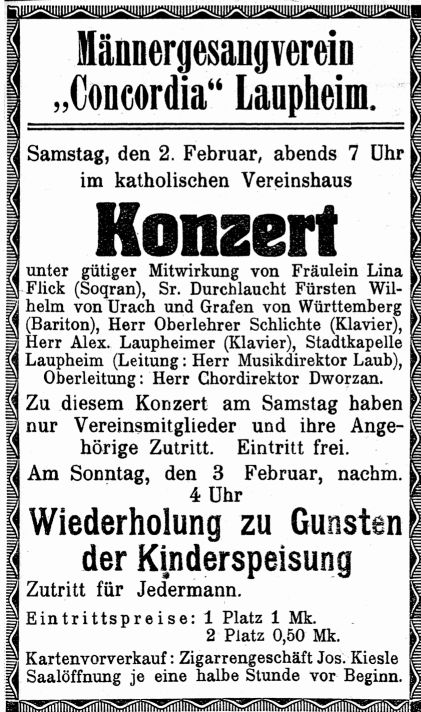 LAUPHEIMER,
Siegfried,
LAUPHEIMER,
Siegfried,
The Jewish
Community
of
La
Book Pages 343 - 349
Translated by:
Simon Jönsson, Lisa Schartner, Anita Ahmadpour, Elena Pozzoni
Supervisor: Dr. Robynne Flynn-Diez,
Ruprecht-Karls-Universität Heidelberg,
CHRIST OPH SCHMID
Samuel “Siegfried” Laupheimer, born March 5, 1882 in Laupheim, died 1955 in New York, USA, [OO Hermine Laupheimer, née Laupheimer, born May 24, 1882 in Laupheim, died January 31, 1913 in Laupheim], OO Bertha Laupheimer, née Laupheimer, born December 24, 1889 in Laupheim, died in the USA, date of death unknown.
Children from his first marriage:
– Alexander Laupheimer, born March 27, 1907 in Munich,
– Simon Laupheimer, born September 22, 1909 in Laupheim,
– Erna Fanny Laupheimer, born December 21, 1911 in Laupheim,
Children from his second marriage:
– Hermine Laupheimer, born June 5, 1919 in Laupheim.
Immigration of Siegfried Laupheimer’s family 1938/39 to the USA

Mittlerer Judenberg: On the left,
Siegfried Laupheimer’s house
(with the stack of wood in front of it).

Newspaper article in the Laupheimer Kurier on December 17, 1936,
stirring up animosity against some of
the Jewish butchers in Laupheim
Siegfried Laupheimer’s real name was Samuel; he was named after his
grandfather. He took up the butcher’s trade just like his grandfather and
his own father Alexander, who had already died in 1907.
In the history of the Jewish community of Laupheim, Siegfried came from one of the two large family lines sharing the surname Laupheimer. Both lines trace back to the common great great grandfather Joseph Laupheimer who died in 1817 and who is buried in the Jewish cemetery in plot number N 3/11. It might be that he was the same Joseph Laupheimer who according to old records was head of the community. Back then, around 1760, the community was still young. As there were many male descendants practising the butcher’s trade in both family lines, it is quite possible that he created the tradition or had inherited the trade from his forefathers and passed it on to his children. Due to the special dietary laws the butcher’s trade was an important and trustworthy profession, which made it compatible with the position as head of the community. Eventually, the Laupheimers diverged into two family lines starting with Joseph’s sons Michael and Alexander. Siegfried Laupheimer was a descendant of Alexander’s line. Interestingly enough, the last generation living in Laupheim saw the two family lines reunited through his marriage, not only once, but twice. In 1901, he married his first wife Hermine Laupheimer when they were both only 19. She came from Michael’s family line and therefore did not have to change her maiden name. Before the outbreak of World War I, they had three children: Alexander, Simon and Erna. Siegfried took over his father’s house at 13 Judenberg which was next to the House of the Dead of the Jewish cemetery. On January 31, 1913, Hermine died and was buried in the cemetery next to their house, in plot number S 2312. The following summer, Siegfried married his first wife’s younger sister Bertha to explicitly confirm the unity of the family. It is possible that she had already taken care of the children since they were born.
Already in August 1914, Siegfried Laupheimer had to join the armed forces. He was stationed as a soldier of the Territorial Army in Heilbronn in the 478th Infantry Regiment of Württemberg. Records show that he fought in the battles of Champagne, of Verdun, and of the Somme in 1918. He was honoured with the Iron Cross 2nd Class and the Order of Merit 3rd Class. He was discharged on November 17, 1918.
Shortly after the war, on June 5, 1919, Siegfried and Bertha Laupheimer could rejoice in the birth of their daughter. She was named Hermine, clearly in honour of Siegfried’s first wife and Bertha’s sister.
In the post war period, Siegfried immediately reassumed the butcher’s trade. He was allowed to use the premises on the ground floor of the small house on the opposite side in the middle of Judenberg. The house belonged to the shoemaker family Gut who was living upstairs.
The apartment was only accessible by wooden stairs outside until it was later renovated. It is said that he would deliver meat by using a cart harnessed to his strong dog. Apparently, he was also a cattle trader.
As was reported by the newspaper
Laupheimer Verkündiger on February 25, 1927, he earned the title of
master craftsman in the same year.
In December 1936, the NS authorities conducted a major campaign in which
they accused him of fraud, namely tax evasion and the forgery of weight
cards. Amongst others, he and his son, who was his apprentice in the
butchery during the Nazi era, were apparently the main targets of the
accusations of the Nazi authorities.
The clearly anti Semitic tendency of the conformed media, especially in the
propaganda newspaper from Ulm named
Der Stürmer, gives the impression that the accusations were trivial and
groundless.

The house of the shoemaker Gut.
The consequence of the accusations and the imposed punishments was that the
family began seriously and urgently considering emigration.
Already in January 1938, Simon Laupheimer immigrated to the USA. The same
year, his father sold the house along with the business premises under
great, constantly growing pressure, and soon followed his son to the USA.
After some time, his wife Bertha and the other children followed. On May 31,
1939, he wrote a letter from New York to his friend and fellow butcher Xaver
Glass in Laupheim reminiscing over times long past that they had spent
together. His letter said:
“Dear friend Glass and dear family Glass!
Last week, I picked up David Löwenthal from the ship, and on Sunday, I met him again, and he said that my old acquaintances sent their regards. Therefore, I no longer wish to wait with writing to you, my dear friend.
So, you and your family are well, and I can say the same about my loved ones and myself. I still think and speak a lot about you all, and I am still glad that we got along so well. I think that if the times and the people had not changed, the two of us would still be working together.”
He continues talking about his new life and gives detailed descriptions
about the butcher's trade in the USA at that time.
“We have a beautiful apartment with a gas stove, an electric refrigerator, and running warm and cold water in the kitchen. Here you don't need any wood, because everything is heated with steam. Our Simon is still working in the same sausage factory in Washington, they produce 10,000 sausages a day, mostly Vienna sausages...”
Siegfried
Laupheimer
died in 1955 in New York. His wife Bertha continued to live there. It is
unknown in which year she died. For the memorial Yad Vashem, she had filled
in some memorial sheets in honour of the victims of the Nazi dictatorship.
Some of them were about former neighbours and relatives from Laupheim.
Alexander
Laupheimer
Alexander was the first child of Siegfried Laupheimer's marriage with Hermine Laupheimer. His place of birth is unusual because amongst all his siblings, he was the only one not to be born in Laupheim, but in Munich. Perhaps they had relatives there. Much about his life is unknown except that he was a merchant and a gifted musician.
At the age of 17 he accompanied the male choral society of Laupheim,
Concordia, on the piano during a
concert. At the same concert, even a nobleman, namely a certain Duke of
Urach (Fürst
von Urach
und Graf von Württemberg),
appeared on stage as a soloist. Alexander Laupheimer's talent was noted in a
review in the newspaper Laupheimer
Verkündiger:
“The young gentleman Alexander Laupheimer accompanied the Waltz Am Wörthersee with high precision, fearlessness and gallantry. He seems to be a person with a musical disposition and a strong sense of rhythm.” (February 8, 1924)
The programme as well as the review showed that there was a harmonious and
natural cooperation between the actors, who belonged to different religions.
This was made possible especially by the long time Jewish cantor Emil
Dworzan, who was in charge of the event’s overall management and who
therefore was lauded.
It is likely that Alexander Laupheimer did not live in Laupheim later on. In
1936, he returned from Düsseldorf and shortly afterwards, he immigrated to
the USA.
Simon Laupheimer
Simon Laupheimer was a merchant. After having lived in the Cologne district
Lindenthal, he moved back to Laupheim in March 1933. As can be seen in the
records of the defamation process against his father Siegfried, he was the
apprentice in his father’s butchery during the Nazi era. In 1938, he managed
to immigrate to the USA.
For a collection of records on the fate of the Jews from Wurttemberg during
the Nazi era, he provided the following information about himself and his
family:
“I was born in Laupheim in 1909. My father Siegfried Laupheimer, born in 1882, was a butcher in Laupheim. He died in New York in 1955. My mother lives at 701 West 180th Street in New York City. My wife was born in Königsbach/Baden in 1908. We got married in 1940 and do not have any children.
Originally, I was a merchant in Laupheim. Later on, I worked as a butcher and owned a restaurant in Washington, D.C., for twenty years. We live in this city and we are active members of the Adas Israel Congregation and the organisation of Achduth. My wife is an active volunteer for the elder care of Hadassah.”
Erna Fanny Laupheimer
There is not much information about Siegfried Laupheimer’s daughter, Erna
Fanny. She worked as a governess. She returned to Laupheim from London on
June 24, 1938. It can therefore be assumed that she had lived and worked in
London for a certain time. According to a letter from the mayor’s office,
Erna Fanny only intended to stay in Laupheim until her father was released
from custody. Shortly thereafter, on January 21, 1939, she moved back to
London and in the very same year she immigrated to the USA.
Hermine Laupheimer
Hermine was Siegfried Laupheimer’s only child from his second marriage with
his wife Bertha. Hermine was referred to as a Haustochter, an
unmarried girl still living with her parents. She returned from Munich on
July 1, 1936, which suggests that she must have lived there for some time.
One year later, on July 20, 1937, she immigrated to New York where she would
soon be reunited with her parents and siblings.
By immigrating to the USA, all members of this Jewish family were able to
escape Nazi persecution and annihilation.
Adolf Alexander
“Jossel” Laupheimer